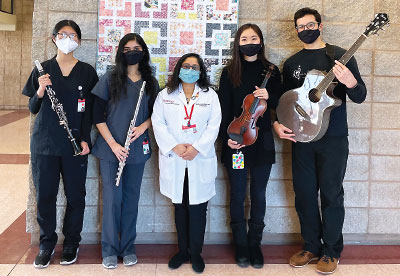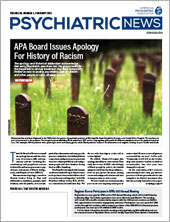The keys to the locked inpatient psychiatric unit jingle as a smiling nurse unlocks the door for Pooja and Isis to enter.
“Welcome back! We’ve got six patients ready for you!” They set up a laptop in the recreation room, connected with Grace and her violin on the other end of a Zoom meeting, as patients stroll in one at a time. The patients sit around a giant table, six feet apart from each other, 49 miles apart from the violinist. After brief introductions, the room becomes filled with various sounds—a jazzy violin rendition of “Fly Me to the Moon” accompanied by bobbing heads, tapping fingers, and light humming. As the final note fades, Pooja asks, “Describe what you’re feeling right now in a couple words.”
“Calm.”
“Fun.”
“Less anxious.”
While their stated moods at times clashed with their visible affects, it was clear that the music had pierced through any barriers between the musicians and patients. Grace continued to play various renditions of well-known classics, and each patient requested a song to share with the group. For those 60 minutes, each patient was identified not by a psychiatric diagnosis, but by musical preferences and expressions.
All of us are members of Vocal Chords, the musicians’ society of Rutgers New Jersey Medical School (NJMS). Supported by the Center for Humanism and Medicine, we provide year-round a capella, classical, and jazz music for the medical school and University Hospital (UH).
Unfortunately, with the onset of the global pandemic, music rehearsals were indefinitely cancelled, and medical students were not permitted on campus. But that did not stop Vocal Chords from making music. A group of 16 medical student musicians recorded a virtual YouTube cover of “Stand by Me” by Ben E. King, allowing us to connect in this socially distant time. We shared this cover with the Newark and NJMS community, providing a positive message of encouragement and support. Recognizing the potential of virtual music, B-SHARP was born.
Beginning a patient care project during a pandemic required us to consider factors such as patient privacy, COVID-19 regulations, and student safety. Students on site with patients log into personal Zoom accounts provided by the school, keeping patient names concealed. The student on the other end logs onto the session—instrument in hand, eagerly smiling. Following COVID-19 regulations, we don personal protective equipment, our temperatures are checked, and chairs are set up in the inpatient psychiatry unit, six feet apart.
B-SHARP would not be possible without help from our dedicated UH chaplaincy and nursing staffs. Despite hectic schedules, the nursing staff welcomed us with cheery smiles that were evident through layers of masks. With the support of the chaplaincy team, we plan on joining the UH spiritual care team and entering notes on our patients’ responses to music into official medical records. Music is medicine, and what better way to illustrate this than having a written record of the role it might have played in a patient’s healing?
After a handful of sessions, we have already seen how music can inspire patients who walked timidly into the room at 4:30 p.m. and danced out of the room in robust conversation about happy memories at 5:30 p.m. The key is following our performances with questions and encouraging our patients to reflect on past memories and how the songs made them feel.
Looking beyond this pandemic, we plan to add more interactive in-person sessions to the B-SHARP repertoire. Having the patients actively involved and contributing to the live music may increase patient engagement and enhance the benefits of music. Particularly, we hope to encourage patients to sing or clap their hands to the rhythm of the songs. The extent to which patients can be involved in the music-making process will depend on patients’ abilities and unique elements of their health conditions, but we hope to adapt these sessions to our patients to make the musical healing as engaging and interactive as possible. ■

